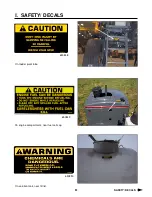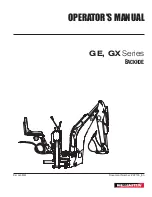
IV.
OPERATING SYSTEMS
25
OPERATING SYSTEMS
HYDROSTATIC LEVER–
The hydrostatic lever
is used to control the direc-
tion of motion of the machine and the speed at which it travels. It is a part of the
ACE hydrostatic drive system or the Automatically Controlled Engine Hydrostatic
Drive. To learn more about the ACE system, refer to the OPERATING SYSTEMS
section B on the hydrostatic drive system.
The lever also houses controls for the spray system and plow functions. For in-
formation on the spray controls, refer to OPERATING SYSTEMS section D on the
spray system. For more information on the plow functions refer to the plow manual.
BRUSH CONTROL-
The brush control dial is used to control the
speed that the brushes are turning. The dial is only functional when the
FLOAT and WORK MODE switches on the side console are on and the
MAIN SPRAY CONTROL/ BRUSH CONTROL switch on the hydrostatic
handle is activated.
Turn the dial away from the operator (counterclockwise) to increase
the speed of the brushes. Turn the dial toward the operator (clockwise)
to reduce the brush speed.
FIG. 4.25-2
THROTTLE SWITCH-
The throttle switch (fig.
4.5A-3) is used to control engine RPM .There are 2 set-
tings that are controlled by the switch, high and low, with
a RPM range of 800 to 2500.
The buttons on the side of the hydrostatic lever (fig.
4.5A-4) are to control the speed ranges within the RPM
setting. For more information on the throttle controls,
refer to OPERATING SYSTEMS section B on the hydrostatic drive system.
FIG. 4.25-3
FIG. 4.25-4
PARKING BRAKE-
The parking brake switch is located next to the
throttle switch on the side console. The switch also controls the ladder. The
brake switch must be on to lower the ladder and to run the side fill or pres-
sure washer (if equipped).
The parking brake is not intended for normal or emergency stopping and
will not engage if machine is moving over 1 mile per hour. Activating the
brake while the machine is still moving is hazardous to the operator and the
sprayer. Bring the sprayer to a complete stop with the hydrostatic lever in the neutral position before applying
the parking brake.
FIG. 4.25-5
FIG. 4.25-1














































